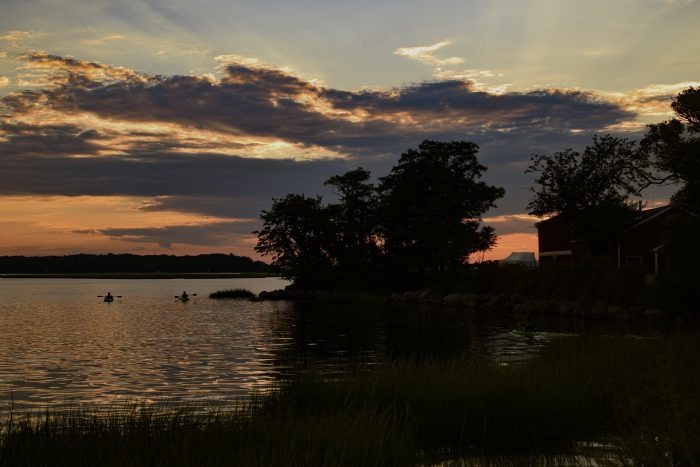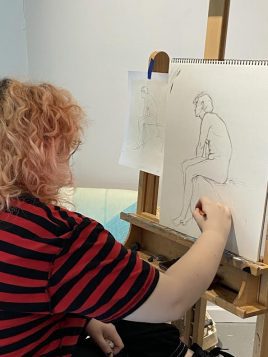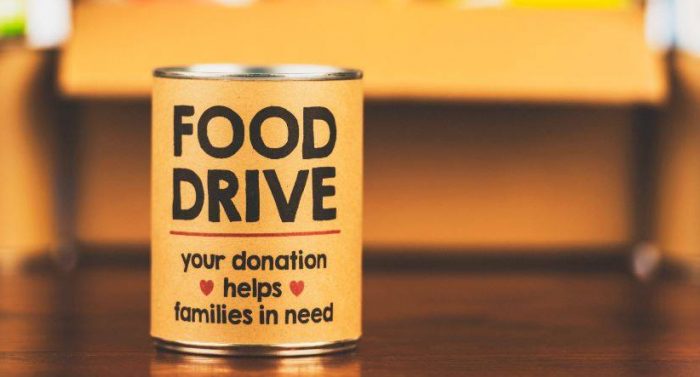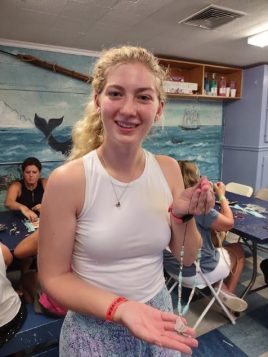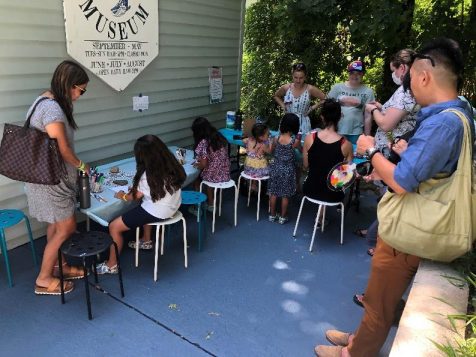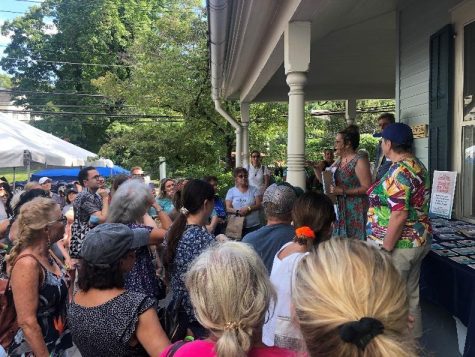Lidl has announced that it will open its 23rd store on Long Island on Wednesday, Aug. 31. Located in the Mayfair Shopping Center at 210 E. Jericho Turnpike in Commack, the grocery store will celebrate its grand opening with a ribbon cutting at 7:40 a.m. The first 100 customers in line before the ribbon cutting will receive gift cards ranging from $5 to $100 each. Shoppers can also enter to win a $500 Lidl gift card, sample Lidl’s award-winning assortment and take advantage of special giveaways throughout the day, according to the franchise. The 30,000-square-foot store will employ more than 50 people and will be open daily from 8 a.m. to 10 p.m.
Medical Compass: Treating obstructive sleep apnea for better health
Consequences can be greater than snoring and fatigue
By David Dunaief, M.D.

Good sleep contributes to our physical and mental wellbeing, however many of us struggle to get quality, restful sleep. For those with obstructive sleep apnea (OSA), quality sleep is especially elusive.
Sleep apnea is an abnormal pause in breathing that occurs at least five times an hour while sleeping. It can have an array of causes, the most common of which is airway obstruction. Some estimates suggest that about 30 million people suffer from sleep apnea in the United States (1).
Obstructive sleep apnea (OSA), also known as sleep-disordered breathing, may affect up to 30 percent of adults. OSA diagnoses are classified as either mild, moderate or severe. It’s estimated that roughly 80 percent of moderate and severe OSA sufferers are undiagnosed.
Risk factors for OSA include chronic nasal congestion, large neck circumference, excess weight or obesity, alcohol use, smoking and a family history (2). Many of these factors, however, are modifiable.
Significant symptoms of OSA tend to be quality of life issues and include daytime fatigue, loud snoring, breathing cessation observed by another, impaired concentration and morning headaches. While these are significant, it’s more concerning that OSA is also associated with an array of more serious health consequences, such as cardiovascular disease, high blood pressure and depression.
Fortunately, we have an arsenal of treatment options, including continuous positive airway pressure (CPAP) devices; oral appliances; lifestyle modifications, such as diet, exercise, smoking cessation and reduced alcohol intake; and some medications.
What is the impact on cardiovascular disease risk?
In an observational study, the risk of cardiovascular mortality increased in a linear fashion with the severity of OSA (3). For those with mild-to-moderate untreated sleep apnea, there was a 60 percent increased risk of death; for those in the severe group, this risk jumped considerably to 250 percent. However, the good news is that treating patients with CPAP considerably decreased their risk by 81 percent for mild-to-moderate patients and 45 percent for severe OSA patients. This study involved 1,116 women over a six-year duration.
Another observational study with male subjects showed similar risks of cardiovascular disease with sleep apnea and benefits from CPAP treatment (4). There were more than 1,500 men in this study with a 10-year follow-up. The authors concluded that severe sleep apnea increases the risk of nonfatal and fatal cardiovascular events, and CPAP was effective in curbing these occurrences.
In a third study, this time involving the elderly, OSA increased the risk of cardiovascular death in mild-to-moderate patients and in those with severe OSA by 38 and 125 percent, respectively (5). But, as in the previous studies, CPAP decreased the risk in both groups significantly. In the elderly, an increased risk of falls, cognitive decline and difficult-to-control high blood pressure may be signs of OSA.
Is there a cancer connection?
In sleep apnea patients under age 65, a study showed an increased risk of cancer (6). The authors believe that intermittent low levels of oxygen, caused by the many frequent short bouts of breathing cessation, may be responsible for the development of tumors and their subsequent growth.
The greater the percentage of time patients spend in hypoxia (low oxygen) at night, the greater the risk of cancer. For those patients with more than 12 percent low-oxygen levels at night, there was a twofold increased risk of cancer development when compared to those with less than 1.2 percent low-oxygen levels.
Does OSA affect male sexual function?
It appears that erectile dysfunction (ED) may also be associated with OSA. CPAP may decrease this incidence. This was demonstrated in a small study involving 92 men with ED (7). The surprising aspects of this study were that, at baseline, the participants were overweight, not obese, on average and were only 45 years old. In those with mild OSA, the CPAP had a beneficial effect in over half of the men. For those with moderate and severe OSA, the effect was still significant, though not as robust, at 29 and 27 percent, respectively.
An array of other studies on the association between OSA and ED have varying results, depending on the age and existing health challenges of the participants. Some study authors have postulated that other underlying health problems may be the cause in some patient populations.
Can diet help?
For some of my patients, their goal is to discontinue their CPAP. Diet may be an alternative to CPAP, or it may be used in combination with CPAP to improve results.
In a small study of those with moderate-to-severe OSA levels, a low-energy diet showed positive results. A low-energy diet implies a low-calorie approach, such as a diet that is plant-based and nutrient-rich. It makes sense, this can help with weight loss. In the study, almost 50 percent of those who followed this type of diet were able to discontinue CPAP (8). The results endured for at least one year.
The bottom line is that if you think you or someone else is suffering from sleep apnea, it is important to be evaluated at a sleep lab and then follow up with your doctor. Don’t suffer from sleep apnea and, more importantly, don’t let obstructive sleep apnea cause severe complications, possibly robbing you of more than sleep. There are many effective treatments.
References:
(1) sleepapnea.org. (2) JAMA. 2004;291(16):2013. (3) Ann Intern Med. 2012 Jan 17;156(2):115-122. (4) Lancet. 2005 Mar 19-25;365(9464):1046-1053. (5) Am J Respir Crit Care Med. 2012;186(9):909-916. (6) Am J Respir Crit Care Med. 2012 Nov. 15. (7) Sleep. 2012;35:A0574. (8) BMJ. 2011;342:d3017.
Dr. David Dunaief is a speaker, author and local lifestyle medicine physician focusing on the integration of medicine, nutrition, fitness and stress management. For further information, visit www.medicalcompassmd.com.
Mather Hospital’s Critical Care team earns national award for excellence
The American Association of Critical-Care Nurses (AACN) has awarded a gold-level Beacon Award for Excellence to Mather Hospital’s Critical Care team in Port Jefferson.
The Beacon Award for Excellence — a significant milestone on the path to exceptional patient care and healthy work environments — recognizes unit caregivers who successfully improve patient outcomes and align practices with AACN’s six Healthy Work Environment Standards. Units that achieve this three-year, three-level award with gold, silver or bronze designations meet national criteria consistent with the ANCC Magnet Recognition Program®, the Malcolm Baldrige National Quality Award and the National Quality Healthcare Award.
“I want to extend my congratulations to Mather Hospital’s Critical Care team on earning a gold-level Beacon Award for Excellence from the American Association of Critical-Care Nurses,” said Mather Hospital CNO/VP for Nursing Marie Mulligan, PhD, RN, CNOR, NEA-BC. “This designation is the highest level of recognition that Critical Care services can achieve for this award.”
“Achieving the gold level AACN Beacon Award for Excellence is a tremendous honor and validates our nursing team’s efforts for providing high quality care and optimal patient outcomes,” said Laura O’Brien RN MSN CRN, NE-BC, Nursing Director of Critical Care at Mather Hospital.
AACN President Beth Wathen, MSN, APRN, CCRN-K, applauded the commitment of the Critical Care caregivers at Mather Hospital for working together to meet and exceed the high standards set forth by the Beacon Award for Excellence. “The Beacon Award for Excellence is a testament to a team’s commitment to providing safe, patient-centered and evidence-based care to patients and families. Creating healthy and supportive work environments empowers nurses and other team members to make their optimal contribution,” Wathen said.
Stone Bridge Nighthawk Watch returns to Setauket Aug. 27

VOLUNTEERS WANTED
It’s that time of year again! Starting on August 27, the Four Harbors Audubon Society will be tallying migrating Common Nighthawks to better understand nighthawk population trends. Join them at the stone bridge at Frank Melville Memorial Park, One Old Field Road, Setauket to witness nighthawks as they pass over during their migratory journey to their wintering grounds in Brazil and Argentina. The watch dates are August 27 to October 6, 5:30 p.m. until dusk. Visit www.4has.org for further details.
Photo of the Week
Michael Boren of Setauket snapped this photo on Aug. 21 at Stony Brook Harbor and aptly titled it “Escaping Into the Sunset.”
Send your Photo of the Week to [email protected]
Nature Matters: A Planetary Birthday Wish
By John L. Turner
August is my birthday month and as I sat staring at the computer screen deliberating the topic for this month’s “Nature Matters” column, the realization occurred to me that I will be celebrating (or at least recognizing) two-thirds of a century of existence. Yes, my 67th trip around the sun on this blessed, pearl blue planet, the only place we know in the entire physical universe where this most unique and fascinating thing called life exists.
So, while I graciously accept your projected birthday greetings, I’m going to devote this column to laying out birthday wishes for Planet Earth, wishes that I humbly request you consider acting upon.
Here’s my eclectic list of wishes for our planetary home and all of its inhabitants:
‘Don’t Bag It’
One of the downsides of our love for the grass lawn is, well, the grass, or more specifically, the cut grass. Common practice for many homeowners is to bag grass clippings, placing the bags at the curb for their municipality to deal with, as though the clippings were a waste product to be gotten rid of. We now know the opposite is true — clippings are an asset which should be left on the lawn to rapidly decompose (or if you object to the clippings being left on the lawn then spread out in your compost pile). Doing so returns moisture and nutrients to the lawn and can reduce your water and fertilizing needs (saving money!). These clippings do not add to the creation of thatch, a common misperception. Plus, grass clippings brought to the dump can result in methane generation, a bad thing since methane is a potent greenhouse gas. Clippings are bad for both the planet and your pocketbook!
Recycle aluminum
Manufacturing aluminum from bauxite ore to turn into cans and foil has enormous environmental impacts. It creates significant air pollution, requires lots of energy, and consumes large amounts of water. It is one of the top ten industries driving climate change. In contrast, making cans and foil from recycled aluminum uses about 5% of the energy needed to make these products from scratch. The good news is aluminum is endlessly recyclable and about two-thirds of consumed aluminum is recycled each year so the more we increase that percentage the less we impact the planet from the effects of bauxite ore mining and aluminum manufacture derived therefrom.
An easy way to promote aluminum recycling is to pick up discarded cans like those you undoubtedly see in parking lots and along roadsides. I see them too and I collect them, putting them in a small plastic bag I keep in the car until I dump them in a much larger bag lining a garbage can. I bring the bags filled with foil and cans to a local waste or scrap metal company (PK Metals on Route 112 in Coram is currently paying 40 cents a pound) and then donate the money to the Four Harbors Audubon Society, creating a true triple win situation — more aluminum recycled, less roadside litter, and funds for conservation. Will you join me in this effort?
Protect birds
Many bird species are in trouble. A recent study has documented a 30% decline — or about 3 billion less birds in North America today than 50 years ago. There are many causes including habitat destruction, feral and pet cats, window strikes, oil spills, drowning due to at-sea fishing activities, ingestion of lead shot and fishing sinkers, and pesticide poisoning, to name but a few. But these problems present opportunities and there’s much we each can do to protect birds by directly responding to these threats — putting window stickers on problem windows so birds can see them, avoiding a fatal collision, keeping your pet cat indoors or if you can’t, make your next pet cat an indoor animal, not using lead split shot and recycling fishing line, drinking shade grown coffee, and throwing away the pesticide can. Birds very much need our help, and let’s remember we are their only hope, so let’s help them!
Be kind to other living things
All life shares a common ancestry that began several billion years ago, when the first signs of life emerged. This is a fact which we can, perhaps uniquely, understand, fostering an opportunity for a kinder, gentler relationship with all living things. So please be kind to them — move turtles out of the road, while driving slow down for squirrels and other wildlife, and practice accommodation by placing outside, unharmed, house-inhabiting spiders, mice, and snakes.
To bolster this view of valuing life’s sanctity, remember a thought your parents probably shared with you when it came to empathy for the predicament of others — “putting yourself in the shoes of another.” Imagine, for a moment, being that box turtle or squirrel trying to get across a road. Wouldn’t you love it for the human driver bearing down on you to take their shoe-clad foot off the gas pedal for a moment or maybe safely pulling to the side of the road, stopping, and moving you out of harm’s way?
Connect to nature by connecting to a local park
Walk slowly through a park or preserve, practicing the Japanese art of “Shinrin-yoku” or forest bathing. It is shown to lower blood pressure and levels of cortisol, a stress hormone. Leave human distraction behind; listen for a variety of bird songs and calls and the deep croaks of frogs, the lapping waves or running water; breathe in the rich scents of the forest or the salty air of the seashore; and quietly observe all the surrounding life, breathing deeply and intently while you do so.
Connect to the vibrancy that is around you — the green fuse of plant life, the orderly activities of ants around an ant mound, the many patterns of tree bark, the cloud formations you take for granted, and the patrols of darting dragonflies. Maybe you’ll even see the blur of an actively feeding ruby-throated hummingbird seeking nectar from jewelweed.
Baba Dioum, a Senegalese forester, said in a speech at the United Nations half-a-century ago: “In the end, we will conserve only what we love, we will love only what we understand, and we will understand only what we are taught.” Go forth, being taught by nature, and fall in love, perhaps for the first time or maybe for the 487th time with her beauty, complexity, and magic.
If these things are done you will have taken measurable steps toward improving your relationship with planet Earth and its treasured forms of life that share the only place in the universe so blessed. What a great birthday present that would be, enough to make me skip the birthday cake.
A resident of Setauket, John Turner is conservation chair of the Four Harbors Audubon Society, author of “Exploring the Other Island: A Seasonal Nature Guide to Long Island” and president of Alula Birding & Natural History Tours.
Art lovers flock to The Atelier at Flowerfield’s Open House Aug. 20
It was a hot, muggy, summer Saturday, as crowds gathered in the cool exhibition hall of The Atelier at Flowerfield for another Open House. Visitors observed portrait drawing demonstrations by Bill Graf, who teaches several classes in painting and drawing. They also watched Fellowship student, Alyssa Kolakowski, warm up with several quick sketches then demonstrate Master drawings.
Those who dropped in were treated to tours of the art studios and Fine Arts Library by Fellowship student, Annie Nate Schindler and Carol D’Amato, Librarian and Teacher Assistant.
On display was the artwork of Fellowship students Annie Nate Schindler and Jonathan Horn.
Guests could also grab a brush and paint along with Carol D’Amato, Teacher’s Assistant and Librarian, as she demonstrated Watercolor painting techniques.
The Fall session begins September 12th with several classes, daytime and evening, in studio and online, in painting (all mediums), drawing, illustration, plein air and a new class in Fashion Textile Design. Every Monday night is Open Figure Night with a live model and its only $20 per 3-hour session! The Atelier also offers lectures and workshops.
The next exhibition, featuring a Fifty-Year Retrospective of Neill Slaughter’s artwork, opens on Thursday, September 8th with a reception from 5:30 to 7:30 p.m.
For more information or to register, go to https://theatelieratflowerfield.org or call 631-250-9009.
Town of Brookhaven launches paint recycling program
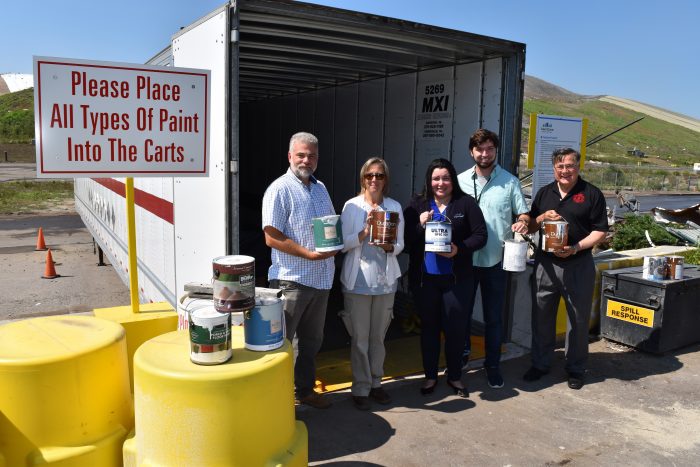
own of Brookhaven Supervisor Ed Romaine (R) recently visited the Residential Drop-Off facility at the Town of Brookhaven Landfill to announce the town’s participation in the New York State Paint Stewardship Program.
Operated by the nonprofit PaintCare and administered by the Town’s Department of Recycling and Sustainable Materials Management (RSMM), this program enables the recycling of architectural paints such as oil-based, latex-based and water-based paints, as well as stains, varnishes and lacquers.
The program, which is funded by a fee on the sale of paint, keeps thousands of gallons of paint from being improperly disposed of each year in the Town of Brookhaven alone.
The paint collected by the town is recycled to the highest extent possible, being remixed into recycled paint; used as fuel; made into other products; or safely disposed of when no other beneficial use can be found.
Brookhaven residents may bring up to 10 gallons per day to the Town of Brookhaven’s Landfill Residential Drop-Off at 350 Horseblock Road in Brookhaven. Hours of operation are Monday through Friday from 7 a.m. to 3 p.m. and Saturday from 7 a.m. to 12 p.m.
Many paint vendors have also signed up as paint recycling drop-offs. A map of all local drop-off locations and a complete list of acceptable items is available at paintcare.org. If you have 100 gallons or more of paint at your home or business, go to paintcare.org and submit a Large Volume Pickup Request form for free large volume pickup service.
Suffolk County Legislator Rob Trotta hosts ‘Get Ready for School Food Drive’
Suffolk County Legislator Rob Trotta is hosting a summer drive to collect non-perishable items for school lunches and snacks, as well as personal care products for the St. Vincent de Paul Food Pantry. The pantry is located at St. Joseph’s Church, 59 Church Street, Kings Park, and is open on Monday and Thursday form 1pm until 4pm. To speak with someone at the pantry, please call 631-269-6635.
Specific items that they are seeking include snack size cookies, chips, pretzels, juice boxes, small bottled water, and salsa and chips. They also need such staples as cereal, bottles of cooking oil, sugar, flour, mustard, mayonnaise, jarred sauce, breadcrumbs, Hamburger Helper, pickles, canned fruit, boxed milk, Pop Tarts, honey, napkins, paper towels, sandwich bags, cleaning supplies and Marble composition books. Personal care items requested are body wash, toothpaste, shaving cream, razors, shampoo, tissues, small hand sanitizers, and laundry detergent.
“During this difficult time, it is important to help our fellow neighbors so donations of these items may be dropped off at my office at 59 Landing Avenue, Suite 1 A, (blue door), Smithtown, from now until September 9, between the hours of 9 a.m. and 4:30 pm,” said Suffolk County Legislator Rob Trotta. For more information, please call Legislator Trotta’s office at 631-854-3900.
Scenes from Suffolk County Seaglass Festival at Cold Spring Harbor Whaling Museum
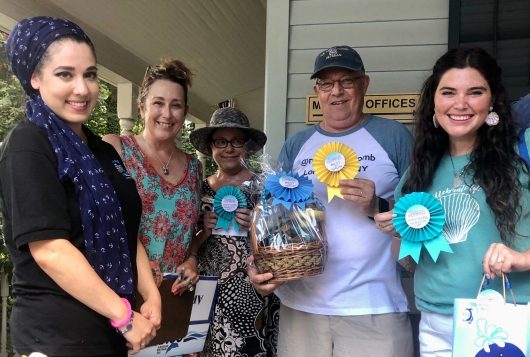
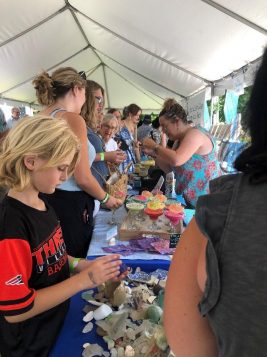
The Whaling Museum and Education Center of Cold Spring Harbor hosted a record-breaking attendance at the first Suffolk County Sea Glass Festival on August 7.
The day invited visitors of all ages to explore and celebrate the world of sea glass and its significance to Suffolk County’s maritime history. The festival hosted over 650 attendees throughout the day at this indoor/outdoor event. These numbers are record-setting for the museum with previous events reaching 285 at most.
“The turnout at our museum was remarkable and surprising – the event brought the highest number of visitors we’ve ever welcomed in one day in the museum’s history. We are so pleased to offer sea glass enthusiasts a place to connect with other beachcombers, explore their interests, and most of all, celebrate what happens when the ocean meets glass. Our staff are now using community feedback to shape next year’s event,” said Executive Director, Nomi Dayan.
Attendees to the event comprised of beachcombers, sea glass enthusiasts, bottle collectors, artists, and families. Some traveled from as far as Connecticut, New Jersey, Pennsylvania, and Florida to attend this first-time event on Long Island.
The museum had approximately 300 to 400 visitors on the property at any given time and stretched event activities to all open areas of the museum and the Wright House, where the museum offices are held. Glass artists and vendors displayed their items on tables on the front lawn and patio, sea glass and antique bottle presentations were held in the museum’s gallery; families with young children did crafts on the newly painted back patio; the Shard of the Year contest was held on the porch of the Wright House; and there was a picnic area set up on the front lawn of the Wright House for attendees to rest and enjoy meals from the event’s food truck.
The Suffolk County Sea Glass Festival welcomed local community members and visitors that had never been to the museum before. Many respondents to a survey sent after the event, said that their favorite part of the Sea Glass Festival was visiting the museum’s exhibits for the first time. The museum embraces this new community and is grateful for all the feedback received before, during and after the event. The positive feedback received through surveys, interviews and on social media has made it evident that the Sea Glass Festival has a place on Long Island and Long Islanders want to continue sharing their passion for sea glass and engaging in conversations about history through the context of these beautiful gems.
This event was supported in part with funds from Suffolk County Office of Cultural Affairs.





